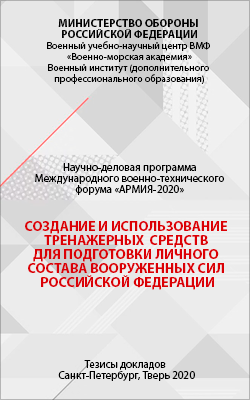Авторитетность издания
Добавить в закладки
Следующий номер на сайте
The optimal control software environment for a nonlinear system class via quadratic criteria
Abstract:The paper presents a distributed software environment for a feedback optimal control synthesis. The control is performed by one class of nonlinear systems via quadratic criteria. This software environment is based on a special method of successive approximations. The successive approximation method convergence is guaranteed in the case of a single optimal control. The software implementation is performed by means of symbolic computation in a distributed environment.
Аннотация:Приведен программный комплекс синтеза оптимального управления с обратной связью одним классом нелинейных систем по квадратичному критерию. Данный комлекс базируется на специальном методе последовательных приближений. Сходимость метода последовательных приближений гарантирована в случае единственного оптимального управления. Оптимальный закон управления в рассматриваемой задаче получается при решении последовательных двухточечных краевых задач. При этом один раз требуется решить матричное дифференциальное уравнение Риккати. Данное уравнение является уравнением с полиномиальной правой частью, и для его решения использован оригинальный метод. Этот метод позволяет найти решение аналитически. В работе рассматривается частный случай динамических систем, в которых динамика описывается дифференциальными уравнениями с полиномиальной правой частью. Поэтому на каждом шаге метода последовательных приближений решение возникающей двухточечной краевой задачи можно получить с помощью упомянутого выше метода приближенного построения аналитических решений. Реализация разработанной вычислительной схемы может быть осуществлена с заранее заданной точностью. Однако в любом случае вычислительный процесс оказывается чрезвычайно трудоемким и требует привлечения специальных современных компьютерных методов и технологий. Для этого авторами разработан соответствующий вы-числительный программный комплекс. Реализация данного комплекса может быть осуществлена только с помощью символьных вычислений в распределенной среде. Разработанный комплекс имеет огромное практическое значение. Это объясняется тем, что подавляющее большинство математических моделей процессов в технике, экономике, экологии и т.д. описываются дифференциальными уравнениями с полиномиальной правой частью. Поэтому предложенный вычислительный программный комплекс может быть использован для решения соответствующих задач оптимального управления в широком диапазоне прикладной научной деятельности.
| Авторы: Афанасьев А.П. (apa@isa.ru) - Институт проблем передачи информации им. А.А. Харкевича РАН (ИППИ РАН), Московский государственный университет им. М.В. Ломоносова (профессор), Москва, Россия, Ph.D, Дзюба С.М. (sdzyuba@mail.ru) - Тверской государственный технический университет (профессор), Тверь, Россия, Ph.D, Емельянова И.И. (emelyanova-123@yandex.ru) - Тверской государственный технический университет (ст. преподаватель), Тверь, Россия | |
| Keywords: , , , optimal control, |
|
| Ключевые слова: symbolic computation in a distributed environment, nonlinear system optimal control via quadratic criteria, successive approximations method, optimal control, distributed software environment |
|
| Количество просмотров: 8161 |
Версия для печати Выпуск в формате PDF (8.21Мб) Скачать обложку в формате PDF (1.09Мб) |
We consider a nonlinear dynamical system which is characterized by a differential equation
where x=(x1, …, xn) is a n-dimensional real state variable vector; u=(u1, …, um) is a m-dimensional real control vector; A and B are real (n´n) and (n´m) matrices; and f=(f1, …, f n) is a vector function defined and continuous together with its partial derivatives Assume that the initial state x(0)=c (2) is fixed and the objective of system control (1) is to minimize the functional
in which T is a fixed finite time, Q and P are a positive semidefinite (n´n) (matrices, R is a positive definite (m´m) matrix, e(t)=x(t)–z(t) is a system error, and z=(z1, …, zn) is a defined operating mode. It is obvious that the direct usage of L.S. Pontryagin’s maximum principle in the problem leads to rather complicated boundary value problem unless (1)–(3) is reduced to a linear-quadratic problem of tracking (e.g., see [1]). However, mostly in practical situations the z(t) mode is designed so that the above reduction is impossible. In general, getting a solution (or solutions ratings) of the problem (1)–(3) requires various methods (e.g., see [2] and [3–9]). One of the principal methods herein is a successive approximations method, which is described in [2]. Seemingly simple and intuitive, it (method) reduces the initial problem to a certain sequence of linear-quadratic problems. However, this method has not achieved widespread use yet, because its the convergence has not been proven. The latter, in particular, due to the fact that in a successive approximations pattern the system operator changes from iteration to iteration. The objective of this paper is the solution of the problem (1)–(3) in the form of the feedback control law. To achieve the main goal we use the procedure which is a modification of the method [2] and includes a creation of some specially generated sequence of auxiliary linear-quadratic problems. In some cases this allows setting the method converges and proving the existence of optimal control, as well as obtaining the procedure of its constructions. We also propose implementation of the method using symbolic calculations in a distributed computing environment, in the case of f function, which is a multicorrect polynomial for x and u variables. The latter gives us a software environment for constructing an optimal control suitable for practical use. Auxiliary problems Let us formally describe the successive approximations method which will be a base for all the further constructions. Following [9], for all N=0,1, … we consider the auxiliary problem of minimizing the functional
with relation
where xN and uN are some defined and continuous functions on the interval [0, T]. For fixed xN and uN the optimal control uN+1(t) in the problem (4), (5) is defined by the feedback control law
in which xN+1(t) is a solution of the equation (5) corresponding with uN+1(t) and satisfying the initial condition xN+1(0)=c, K(t) is a solution of the matrix Riccati differential equation
with a boundary condition K(T)=P, (8) and hN+1(t) is a solution of a linear differential equation
with a boundary condition hN+1(T) = Pz(t) (10) (see [1]). Thus, if the initial approximation x0(t), u0(t) is given, the relations (4)–(10) determine a successive approximations pattern, which, as shown below, for all considerably small values T and provides an effective procedure for constructing the solution of the problem (1)–(3). We also note that, for simplicity, the initial approximation is to be determined by the relations x0(t)=c (11) and Remark. Independence of the system (1) and constancy of matrices Q and R in this paper are not used anywhere else and taken to simplify the notation. Control construction We apply the method (6)–(12) to study the simplest variation of the problem (1)–(3), where the value of T is expected to be sufficiently small. Such a problem will be called local. The existence and structure of the optimal controls in a local problem (1)–(3) established following
where x*(t) is a solution of the equation
with the initial condition x*(t) =c, (15) and h*(t) is a solution of the equation
with the boundary condition x*(t) =Pz(T). (17) Software environment Let`s consider the problem of the above proposed method (6)–(12) implementation for the equation (1)–(3) with f function that is multidimensional polynomial of variables x, u. For simplicity we restrict oursevlves to the case of regular sequences (18) and a hypothesized approximation of z(t) function by some polynomial. First and foremost, it should be noted that the first step in the method implementation is building up a Riccati equation (7) with the boundary condition (8). As it is evident that this equation is a polynomial on the right side. Thus, we can use a special method of work [14] for building up an approximate analytical solution. Method from [10] uses the procedure of multiple symbolic integration of multidimensional polynomials. As a result, we successed in building up the approximate analytical solution of the function (7) in the form of multidimensional polynomial of time t and matrix P (see (8)). Furthermore, this approximate solution is always built up with prescribed precision. In addition, the build-up itself uses services of multidimensional polynomial symbolic integration and symbolic multiplication positioned in the computer environment. The next step of the method implementation (6)–(12) is building-up of an effective control action. According to the conclusion this building assumes implementation of preliminary transition for solutions of sequences of two point-boundary value problems (5), (9), (10) where corresponded differential equations are interconnected with the function (6). To build-up the solution of this problem we consider Cauchy problem (5), (9), wherein a boundary condition is replaced by an initial condition h(0)=d. (18) At each step of the successive approximations method (6)–(12) differential equations (5) and (9) and in task (5), (9), (18) are linear, where time t appears in right sides of these equations as polynomial. Thus, it is also possible to use method of work [10] to obtain the solution of this problem. Using the method from [10] approximate analytical solution of equations (5), (9), (18) is always obtainable with prescribed precision in the form of multidimensional polynomial of variables t, c, d. Obviously it allows avoiding rather complicated procedure of the solution of two point-boundary value problems (5), (9), (10) by means of d vector selection in the initial condition (18) implementing the boundary condition (10). Thus, the method of successive approximations (6)–(12) is rather easily implemented in the distributed computer environment using services of multidimensional polynomial symbolic integration and symbolic multiplication. References 1. Athans M., Falb P. Optimal Control. McGraw-Hill Publ., New York, 1966. 2. Bellman R. Adaptive Control Processes. Princeton Univ. Publ., Princeton, 1961. 3. Lukes D.L. Optimal regulation of nonlinear systems. SIAM J. Control Optim. 1969, vol. 7, pp. 75–100. 4. Yamamoto Y. Optimal control of nonlinear systems with quadratic performance. J. Math. Anal. Appl. 1978, vol. 64, pp. 348–353. 5. Dacka C. On the controllability of a class of nonlinear systems. IEEE Trans. Automat. Control. 1980, vol. 25, pp. 263–266. 6. Balachandran K., Somasundaram D. Existence of optimal control for nonlinear systems with quadratic performance. J. Austral. Math. Soc. Ser. B. 1987, vol. 29, pp. 249–255. 7. Afanas'ev A.P., Dzyuba S.M., Lobanov S.M., Tyutyun- nik A.V. Successive approximation and suboptimal control of systems with separeted linear part. Appl. Comp. Math. 2003, vol. 2, no. 1, pp. 48–56. 8. Afanas'ev A.P., Dzyuba S.M., Lobanov S.M., Tyutyun- nik A.V. On a suboptimal control of nonlinear systems via quadratic criteria. Appl. Comp. Math. 2004, vol. 3, no. 2, pp. 158–169. 9. Afanas'ev A.P., Dzyuba S.M. Optimal Control of Nonlinear Systems via Quadratic Criteria. Trudy ISA RAN [Trans. of ISA RAS]. 2008, vol. 32, pp. 49–62 (in Russ.). 10. Afanas'ev A.P., Dzyuba S.M., Kirichenko М.А., Ruba- nov N.А. Approximate analytical solution systems of ordinary differential equations with polynomial right-hand side. ZhVM and MF. 2013, vol. 53, no. 2, pp. 321–328 (in Russ.). |
| Постоянный адрес статьи: http://swsys.ru/index.php?page=article&id=4022&lang= |
Версия для печати Выпуск в формате PDF (8.21Мб) Скачать обложку в формате PDF (1.09Мб) |
| Статья опубликована в выпуске журнала № 3 за 2015 год. [ на стр. 19-21 ] |
Возможно, Вас заинтересуют следующие статьи схожих тематик:



 (1)
(1) and
and  in euclidean vector space
in euclidean vector space  .
.
 (3)
(3)
 (4)
(4) x(0)=c, (5)
x(0)=c, (5) (6)
(6) (7)
(7)
 (9)
(9) (12)
(12) (13)
(13) (14)
(14) (16)
(16)
